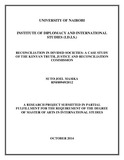| dc.description.abstract | The violence witnessed in Kenya in the aftermath of the 2007 disputed presidential elections shook
Kenyans into the realization that Kenya had remained a highly polarized nation since independence.
Brother turned against brother resulting in the loss of than 1,300 lives and the displacement of more than
300,000 people. International agencies stepped in with the AU taking the lead in a bid to seek a
cessation to the violence. An agreement was finally sealed on February 28, 2008 through the KNDRC
process mediated by former UN Secretary General Kofi Annan. The agreement led to inter alia the
cessation of violence and formation of a coalition government. However, the mediation efforts could
have only done so much. There were long-term issues that needed specialized agencies to fully resolve.
With this understanding the KNDRC agreed on a number of commissions to be formed to handle these
issues.
The Commission of Inquiry into the Post-Election Violence (Waki Commission), the National Cohesion
and Integration Commission – the only permanent commission – and finally the TJRC were among
commissions formed to handle the long-term issues of the conflict. The Waki Commission in its report
recommended the formation of a Special Tribunal for Kenya to try the people suspected to bore criminal
responsibility for the PEV. However, the Special Tribunal of Kenya never saw the light of day.
Consequently, the ICC stepped in and took up the cases after the then ICC Prosecutor Moreno Ocampo
received the names of people suspected to bear criminal responsibility for the PEV from Kofi Annan.
The TJRC was finally established in 2009 to among others promote justice, healing and reconciliation in
Kenya. It was formed at a time when the ICC was in the process of confirming charges against six
Kenyans in relation to the 2007 / 2008 PEV. At the time many Kenyans viewed the TJRC as a ploy by
those in government to shield the merchants of impunity from criminal prosecution.
The TJRC problems were further compounded by the credibility crisis that faced its’ chairperson –
Ambassador Bethuel Kiplagat. The issues surrounding the chairperson threatened to tear the commission
apart and derail the truth seeking process. The crisis led to the resignation of the then vice-chairperson –
Ms. Betty Murungi. This left the TJRC with only seven commissioners when the chairperson finally
stepped aside. Throughout its’ work the commission was further plagued by financial challenges as well
as lack of political will in the truth seeking process.
The TJRC worked for four years and finally handed in its’ report in May 2013. The commissioners
noted that reconciliation is not an event but a process. Consequently, the TJRC interpreted its mandate
as being to initiate the process of reconciliation. The TJRC held a number of public hearings and
reconciliation forums to aid in the initiation of reconciliation between and among the different Kenyan
ethnic groups. The research concludes that despite the many challenges experienced by the TJRC, it did
actually lay the foundation for reconciliation. It is imperative that the government endeavours to
implement the commission’s recommendations if reconciliation is to be fully realized in the country. It
is equally important that the rule of law is observed so that the citizens can rest assured that justice and
fairness will prevail. | en_US |

